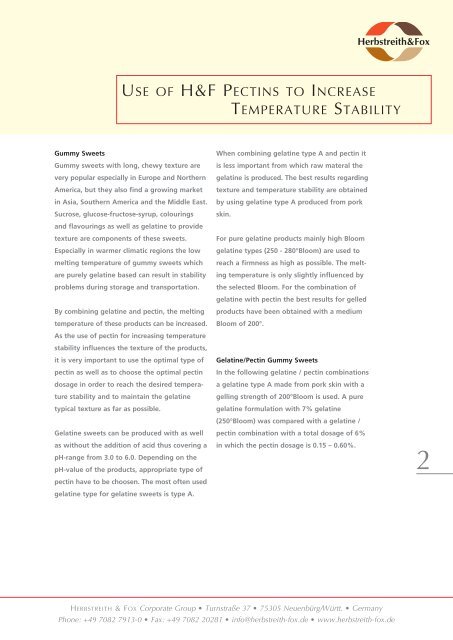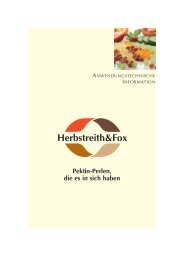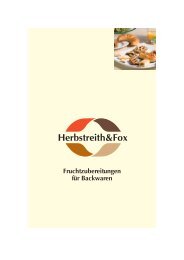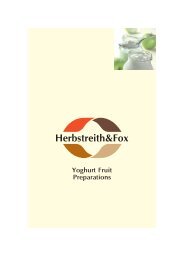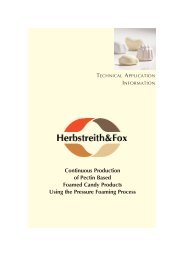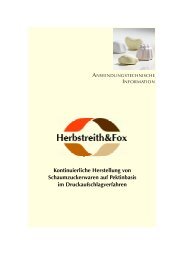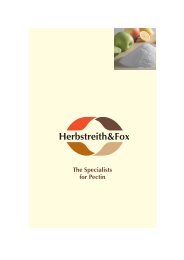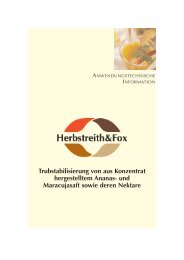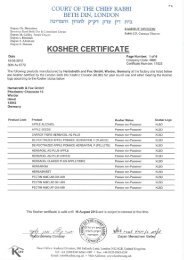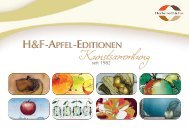Use of H&F Pectins to Increase Temperature ... - Herbstreith & Fox
Use of H&F Pectins to Increase Temperature ... - Herbstreith & Fox
Use of H&F Pectins to Increase Temperature ... - Herbstreith & Fox
Create successful ePaper yourself
Turn your PDF publications into a flip-book with our unique Google optimized e-Paper software.
<strong>Use</strong> <strong>of</strong> h&f pecTins To increase<br />
TemperaTUre sTabiliTy<br />
Gummy Sweets<br />
Gummy sweets with long, chewy texture are<br />
very popular especially in Europe and Northern<br />
America, but they also find a growing market<br />
in Asia, Southern America and the Middle East.<br />
Sucrose, glucose-fruc<strong>to</strong>se-syrup, colourings<br />
and flavourings as well as gelatine <strong>to</strong> provide<br />
texture are components <strong>of</strong> these sweets.<br />
Especially in warmer climatic regions the low<br />
melting temperature <strong>of</strong> gummy sweets which<br />
are purely gelatine based can result in stability<br />
problems during s<strong>to</strong>rage and transportation.<br />
By combining gelatine and pectin, the melting<br />
temperature <strong>of</strong> these products can be increased.<br />
As the use <strong>of</strong> pectin for increasing temperature<br />
stability influences the texture <strong>of</strong> the products,<br />
it is very important <strong>to</strong> use the optimal type <strong>of</strong><br />
pectin as well as <strong>to</strong> choose the optimal pectin<br />
dosage in order <strong>to</strong> reach the desired temperature<br />
stability and <strong>to</strong> maintain the gelatine<br />
typical texture as far as possible.<br />
Gelatine sweets can be produced with as well<br />
as without the addition <strong>of</strong> acid thus covering a<br />
pH-range from 3.0 <strong>to</strong> 6.0. Depending on the<br />
pH-value <strong>of</strong> the products, appropriate type <strong>of</strong><br />
pectin have <strong>to</strong> be choosen. The most <strong>of</strong>ten used<br />
gelatine type for gelatine sweets is type A.<br />
When combining gelatine type A and pectin it<br />
is less important from which raw materal the<br />
gelatine is produced. The best results regarding<br />
texture and temperature stability are obtained<br />
by using gelatine type A produced from pork<br />
skin.<br />
For pure gelatine products mainly high Bloom<br />
gelatine types (250 - 280°Bloom) are used <strong>to</strong><br />
reach a firmness as high as possible. The melting<br />
temperature is only slightly influenced by<br />
the selected Bloom. For the combination <strong>of</strong><br />
gelatine with pectin the best results for gelled<br />
products have been obtained with a medium<br />
Bloom <strong>of</strong> 200°.<br />
Gelatine/Pectin Gummy Sweets<br />
In the following gelatine / pectin combinations<br />
a gelatine type A made from pork skin with a<br />
gelling strength <strong>of</strong> 200°Bloom is used. A pure<br />
gelatine formulation with 7% gelatine<br />
(250°Bloom) was compared with a gelatine /<br />
pectin combination with a <strong>to</strong>tal dosage <strong>of</strong> 6%<br />
in which the pectin dosage is 0.15 – 0.60%.<br />
2<br />
herbsTreiTh & fox Corporate Group • Turnstraße 37 • 75305 Neuenbürg/Württ. • Germany<br />
Phone: +49 7082 7913-0 • Fax: +49 7082 20281 • info@herbstreith-fox.de • www.herbstreith-fox.de


